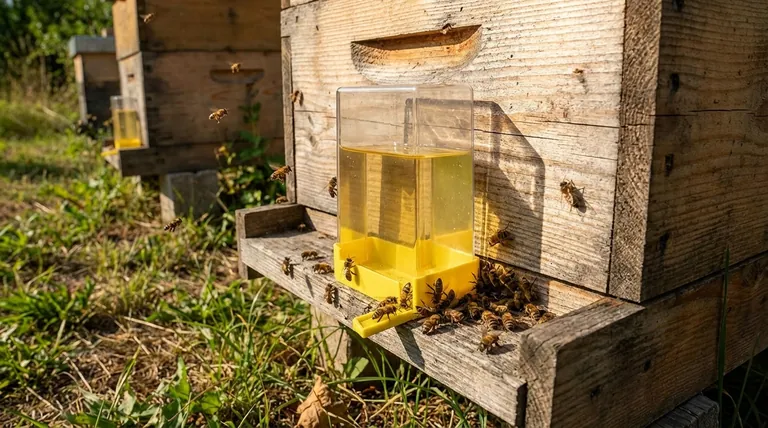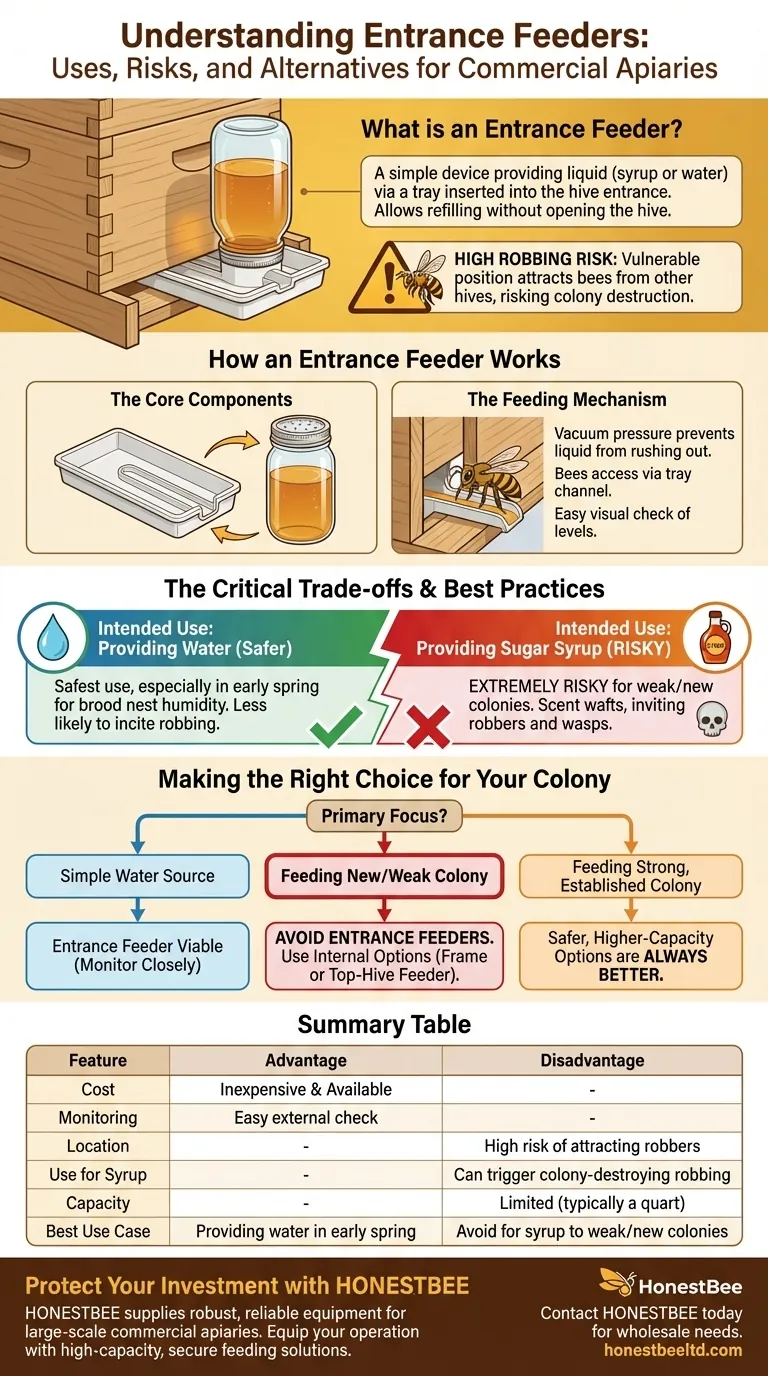At its core, an entrance feeder is a simple device used to provide liquid—either sugar syrup or water—to a honey bee colony. It consists of a container, typically an inverted mason jar, which screws onto a plastic or wooden tray that slides into the main entrance of the hive. This design allows a beekeeper to refill the feeder without opening the hive.
While entrance feeders are inexpensive and easy to monitor, their position at the hive's front door makes them highly prone to attracting bees from other hives. This creates a significant risk of "robbing," a behavior that can quickly overwhelm and destroy a colony.

How an Entrance Feeder Works
An entrance feeder's design is straightforward, relying on vacuum pressure and the hive's existing structure.
The Core Components
The system has two parts. The first is a feeding tray with a channel that sits inside the hive entrance and a base that remains outside.
The second part is a standard jar with small holes punched in the lid. When filled with liquid and inverted onto the tray, a vacuum prevents the liquid from rushing out all at once.
The Feeding Mechanism
Bees can access the liquid by walking to the front of the hive and extending their proboscis through the feeding tray's channel. This allows them to draw out syrup or water as needed. Because the jar is external and often clear, the beekeeper can see the liquid level at a glance.
The Intended Use vs. The Reality
While simple in concept, the entrance feeder's most convenient feature—its location—is also its greatest liability.
Providing Water
The safest use for an entrance feeder is to provide a clean water source, especially in early spring. At this time, bees need water to liquefy crystallized honey and to regulate brood nest humidity, but natural sources may be scarce or cold. Using a feeder for water is less likely to incite robbing behavior.
Providing Sugar Syrup
Beekeepers feed sugar syrup to support a new colony, help a weak hive build up, or provide nourishment during a nectar dearth. Unfortunately, using an entrance feeder for syrup is extremely risky. The scent of sugar wafts directly from the hive entrance, acting as an open invitation to nearby bees and wasps.
Understanding the Critical Trade-offs
The choice to use an entrance feeder involves weighing its low cost and convenience against a significant and often devastating risk.
The Primary Risk: Robbing
Robbing occurs when bees from a stronger hive discover a weak hive's food stores and attack it to steal them. An entrance feeder is like a flashing neon sign advertising a free meal.
Once robbing begins, the defending bees are often overwhelmed and killed. The entire colony can be stripped of its honey and collapse within a day or two. Weak or new colonies are especially vulnerable and should never be fed syrup with an entrance feeder.
The Benefit: Low Cost and Visibility
Entrance feeders are among the cheapest feeders available. Their external placement means you can check and refill them without disturbing the colony by opening the hive, which reduces stress on the bees.
The Drawback: Limited Capacity and Exposure
Most entrance feeders use a quart-sized jar, which may not be enough for a colony in urgent need. The external placement also exposes the syrup to sunlight, which can cause it to ferment or degrade, and to temperature swings that can cause the vacuum seal to break and leak.
Making the Right Choice for Your Colony
Choosing the correct feeder is a critical decision that directly impacts your colony's health and security.
- If your primary focus is providing a simple water source: An entrance feeder is a viable option, but you must monitor it closely for any unusual activity from other hives.
- If your primary focus is feeding a new or weak colony: Avoid entrance feeders for syrup at all costs. The risk of initiating robbing is far too high. Instead, use an internal option like a frame feeder or a top-hive feeder.
- If your primary focus is feeding a strong, established colony: While a strong hive may be able to defend an entrance feeder, it still advertises food to the entire area and can start a robbing frenzy among other nearby hives. Safer, higher-capacity options are always a better choice.
Ultimately, protecting your bees is more important than the minor convenience an entrance feeder offers for feeding syrup.
Summary Table:
| Feature | Advantage | Disadvantage |
|---|---|---|
| Cost | Inexpensive and readily available | - |
| Monitoring | Easy to check levels without opening hive | - |
| Location | - | High risk of attracting robbers |
| Use for Syrup | - | Can trigger colony-destroying robbing |
| Capacity | - | Limited (typically a quart jar) |
| Best Use Case | Providing water in early spring | Avoid for feeding syrup to weak/new colonies |
Protect Your Investment and Ensure Your Apiary's Success
Understanding the right equipment for each situation is key to successful beekeeping. While an entrance feeder has its place, using the wrong feeder can lead to catastrophic losses.
HONESTBEE supplies commercial apiaries and beekeeping equipment distributors with the robust, reliable equipment needed for large-scale operations. We understand that your bottom line depends on the health and security of your colonies.
Let us help you equip your operation for success with high-capacity, secure feeding solutions and other essential supplies.
Contact HONESTBEE today to discuss your wholesale needs and build a stronger, more secure apiary.
Visual Guide

Related Products
- Professional Hive Front Entrance Bee Feeder
- Boardman Entrance Bee Feeder Durable Galvanized Steel and Wood Construction for Beekeeping
- HONESTBEE Entrance Bee Feeder Professional Hive Nutrition Solution for Beekeeping
- Classic Boardman Entrance Bee Feeder Hive Front Feeding Solution
- HONESTBEE Entrance Bee Feeder Efficient Hive Front Liquid Feeding Solution for Beekeeping
People Also Ask
- How do you make an entrance feeder for bees? A Guide to Safe & Effective Hive Feeding
- How does the entrance feeder method work? A Guide to Simple But Risky Hive Feeding
- How does an entrance feeder work? A Guide to Its Simple Mechanics and Risks
- How does a beehive entrance feeder work? A Simple Guide to Supplemental Feeding
- How to make an entrance feeder for bees? A DIY Guide for Safe & Effective Feeding



















